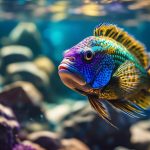Rotala indica, commonly known as the Indian toothcup, has captivated aquarists with its enchanting beauty and impressive adaptability. Originating from the rice paddies of Southeast Asia and India, this aquatic plant boasts a unique appearance with its long, pointed leaves that transition from green to yellow as it matures.
Growing in clusters, it creates a dense and bush-like aesthetic that adds a touch of elegance to any aquarium. But what sets Rotala indica apart is not just its stunning appearance but also its ability to improve oxygen availability and water conditions.
With its rapid growth rate, proper care and maintenance are crucial to prevent it from overpowering the tank. So, let's explore the fascinating world of Rotala indica, from its discovery and natural habitat to propagation techniques and color variations, and discover why it has become a sought-after choice among aquarists worldwide.
Key Takeaways
- Rotala indica is a popular aquatic plant among aquarists worldwide, known for its beautiful appearance and rapid growth rate.
- It has long, pointed grass-like leaves that can turn yellow as the plant matures, creating a dense bush-like appearance.
- Rotala indica is easy to care for and suitable for beginners, adapting well to a wide variety of freshwater conditions.
- The plant has high light requirements for optimal growth, with the intensity of light affecting its color and appearance.
Discovery and Natural Habitat
Rotala indica, also known as the Indian toothcup, was first discovered in 1891 by Bernhard Adalbert Emil Koehne. This aquatic plant is naturally found in rice paddies across Southeast Asia and India. Its discovery history traces back to Koehne's exploration of the region, where he encountered this unique species thriving in the muddy, nutrient-rich waters of rice fields.
Rotala indica's geographical distribution spans across countries such as Thailand, Vietnam, Cambodia, and Bangladesh, reflecting its adaptability to various climates and water conditions. Its ability to survive and thrive in these environments has made it a popular choice among aquarists worldwide.
This plant's natural habitat and distribution highlight its resilience and ability to serve as a valuable addition to aquatic ecosystems.
Appearance and Size
With long, pointed grass-like leaves and clusters of yellow-tipped, concave foliage, Rotala indica exhibits a distinct and visually appealing appearance. This aquatic plant has a unique charm that adds beauty to any aquarium.
Here are some key features of Rotala indica's appearance and size:
- Long, pointed grass-like leaves
- Clusters of yellow-tipped, concave foliage
- Dense bush-like appearance near the stems
- Average size of 2 inches, but can grow up to 2 feet with proper care and tank conditions
Rotala indica's appearance makes it an attractive choice for aquascaping enthusiasts. Its size can be controlled through proper propagation techniques and careful adjustments to tank conditions. By providing the right environment and care, this plant can flourish and enhance the aesthetics of any aquarium.
Care and Maintenance

Having discussed the appearance and size of Rotala indica, it is important to understand the care and maintenance required to ensure the growth and health of this aquatic plant.
Rotala indica is easy to care for, making it suitable for beginners. A tank size of at least 10 gallons is recommended for proper growth. The plant adapts well to a wide variety of freshwater conditions, but regular water parameter checks and 25% water changes every two weeks are necessary to maintain a healthy environment.
Rotala indica has high light requirements for optimal growth, with 3 to 5 watts full-spectrum bulbs providing 5000 to 7000k per gallon recommended. Pruning techniques are essential to maintain the desired arrangement and promote growth.
Light Requirements and Growth Rate
To ensure the successful growth and development of Rotala indica, it is crucial to provide the appropriate light requirements and understand its impact on the plant's growth rate. Here are some key points to consider:
- Light intensity plays a significant role in the growth of Rotala indica. Higher light intensity results in reddish stems, while low light environments produce larger leaves.
- It is recommended to use 3 to 5 watts full-spectrum bulbs providing 5000 to 7000k per gallon to meet the plant's light requirements.
- The exposure to light also affects the growth rate of Rotala indica. Adequate light promotes rapid growth and prevents the plant from becoming leggy.
- Pruning techniques should be employed to maintain the desired shape and promote healthy growth of the plant.
Benefits and Aesthetic Value

Rotala indica offers a multitude of benefits and adds significant aesthetic value to any aquarium. This beautiful plant not only enhances the visual appeal of the tank but also provides several advantages for its inhabitants.
One of the key benefits of Rotala indica is its ability to improve oxygenation in the aquarium. Through photosynthesis, the plant releases oxygen into the water, creating a healthier and more oxygen-rich environment for fish and other aquatic organisms. This promotes their overall well-being and supports their respiratory functions.
Additionally, Rotala indica serves as a valuable source of nutrition for scavengers in the tank. As the plant grows, it accumulates organic matter and detritus, which are essential food sources for bottom-dwelling organisms such as snails and shrimp. These scavengers play an important role in maintaining the cleanliness of the aquarium by consuming these waste products.
To summarize, Rotala indica not only enhances the visual appeal of the tank with its vibrant colors and bush-like appearance but also contributes to improved oxygenation and scavenger nutrition. It is a valuable addition to any aquarium, providing both aesthetic value and functional benefits.
| Benefits of Rotala indica | Aesthetic Value of Rotala indica |
|---|---|
| Improved oxygenation | Adds vibrant colors to the tank |
| Scavenger nutrition | Creates a bush-like appearance |
| Enhances the overall beauty |
Placement and Design Ideas
When considering the placement and design of Rotala indica in an aquarium, careful thought must be given to its unique growth habits and aesthetic qualities. This beautiful plant offers a range of possibilities for creative aquarium landscaping.
Here are some ideas to inspire your arrangements:
- Background Elegance: Rotala indica is best suited for the tank background. Placing it at corners can create elegant bushes that add depth and visual interest to the aquarium.
- Topiary Art: With its round leaves and sturdy stem, Rotala indica can be trimmed into round shapes resembling topiary art. This adds a touch of sophistication and uniqueness to the tank design.
- Underwater Landscape: Assembling Rotala indica in clusters can create an underwater landscape, with its dense bush-like appearance serving as a focal point. Combine it with other plants like Hemianthus callitrichoides for a vibrant mix of colors.
- Ornamental Accents: The bright oval leaves of Rotala indica provide an ornamental look to the tank. Use it strategically as accents or focal points to enhance the overall aesthetic appeal of the aquarium.
Propagation Techniques

The propagation techniques for Rotala indica involve careful handling and adherence to specific methods to ensure successful reproduction and growth of this beautiful aquatic plant. To propagate Rotala indica, it is important to consider the following propagation tips and optimal planting techniques.
First, allow the plant to acclimatize before planting. This helps the plant adjust to its new environment and reduces stress.
Next, cut the plant with enough allowance for regrowth. Ensure that the stem is healthy and free from any damage.
When planting the stem, it is crucial to firmly insert it into the substrate. This promotes root development and ensures stability. Additionally, providing nutrients through fertilizers and CO2 injections can enhance the growth of Rotala indica. CO2 injections are particularly useful in promoting rapid growth.
Lastly, pruning is essential to maintain the desired arrangement and promote growth. Regularly trim any overgrown stems and remove any dead or decaying leaves.
Color Variations and Tank Conditions
Color variations and the overall appearance of Rotala indica are highly influenced by the tank conditions in which it is grown. The following factors play a crucial role in determining the coloration of Rotala indica:
- Effect of lighting: The intensity and spectrum of light have a significant impact on the plant's coloration. High light intensity promotes reddish stems, while low light environments result in larger leaves.
- Water parameters: Maintaining the right water parameters is essential for optimal plant growth. Proper nutrient levels, pH, and temperature contribute to vibrant coloration. It is important to regularly check and adjust these parameters to create an ideal environment for Rotala indica.
- Substrate quality: A nutrient-rich substrate provides essential elements for the plant's growth and color development. Using a high-quality substrate specifically designed for aquatic plants can enhance the overall appearance of Rotala indica.
- CO2 supplementation: Carbon dioxide injections can significantly influence the plant's growth and coloration. Adequate CO2 levels promote vigorous growth and intensify the plant's color.
Creating the right tank conditions that incorporate these elements will ensure the best color variations and overall health of Rotala indica.
Frequently Asked Questions
How Long Does It Take for Rotala Indica to Reach Its Full Size?
The growth rate of Rotala indica can vary depending on various factors such as light intensity, water conditions, and care provided. On average, it can reach its full size of 2 feet within a few weeks to a couple of months under optimal conditions.
Can Rotala Indica Be Grown in a Saltwater Aquarium?
Rotala indica is not suitable for growth in a saltwater aquarium as it naturally thrives in freshwater conditions. Specific farming techniques for Rotala indica focus on freshwater parameters and requirements for optimal growth and health.
What Is the Recommended Temperature Range for Rotala Indica?
The recommended temperature range for Rotala indica is between 68°F and 82°F (20°C – 28°C). To care for Rotala indica in different temperature conditions, ensure proper lighting, water parameters, and adjust temperature accordingly to maintain optimal growth and health.
Can Rotala Indica Survive in Low Light Conditions?
Tips for maintaining Rotala Indica in low light conditions include providing supplementary lighting, using full-spectrum bulbs with a color temperature of 5000 to 7000k per gallon, and ensuring regular fertilization to compensate for reduced photosynthesis. Lighting greatly impacts the growth of Rotala Indica.
Does Rotala Indica Produce Flowers?
Yes, Rotala indica does produce flowers. It is a beautiful addition to freshwater aquariums, known for its vibrant colors and bush-like appearance. The ideal temperature range for Rotala indica is 72-82°F.










